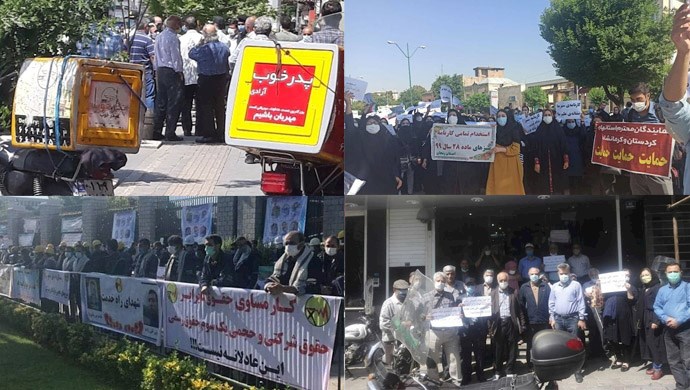Analysis by PMOI/MEK
Iran, May 10, 2021—Tension is growing across Iran. Every day, different communities and segments of the Iranian society hold demonstrations and protest the regime’s corruption, destructive policies, and oppression.
On Sunday, defying a wave of repressive measure by the Iranian regime, retirees and pensioners of the Social Security Organization took to the streets and held protest rallies in 13 cities. In the past four months, the pensioners have organized regular protests, sometimes two or three times a week.
On the same day, teacher graduates from different cities gathered in Tehran and held a large rally, protesting unemployment and the regime’s false and unfulfilled promises.
Meanwhile, middle and high school students held demonstrations for several consecutive days in six cities, demonstrating the regime’s decision to bypass covid protocols and require students to attend in-person exams.
The one thing that unites all these protests is the direct targeting of the mullahs’ regime as the main source of all grievances in the country. The pensioners were chanting, “imprisoned workers must be freed,” “We will not vote, we’ve heard too many lies,” “We’re faced with discrimination and coronavirus, and no one is thinking about us,” “retirees rise and stand up against discrimination and tyranny.”
Regime authorities are alarmed at the escalating situation of protests. “Regarding [social] protests, what’s important is that the issue is transforming from simple demands in a civic form to a security issue,” the state-run Mostaghel daily warned on May 9.
After suppressing the November 2019 uprising, the regime banked on the coronavirus outbreak to prevent the eruption of further social protests. Regime supreme leader Ali Khamenei went as far as calling the covid outbreak as a “blessing.”
But in the current situation, which according to Mostaghel, “poverty and misery is cutting to the bones of families” to the point that “students are committing suicide,” not even the coronavirus pandemic can keep the people’s rage in check. Testament to the fact is the gradual escalation of protests in the past four months. The pensioners started their protest movement in a few cities. But in the following weeks, communities from many other cities joined the movement. And the atmosphere spread to Iranian communities from other walks of life, including workers, teachers, students, creditors, and farmers.
The developing situation has not gone unnoticed to Khamenei and the regime’s security and repression apparatus. But the regime is faced with a deadlock in addressing the simmering rage of the society. On the one hand, if the regime resorts to sheer repression, as it did in the November 2019 protests, it will reopen recent wounds and further pour fuel on the fire of the people’s rage toward the regime. On the other hand, if the regime stands by, the protests will continue to expand and draw even more communities and segments of the society. The conditions of Iran’s society are more explosive than ever.
This deadlock and the regime’s reluctance and dithering has caused the expansion of protest movements in the past four months. As the Jahan-e Sanat daily warned on April 16, regime officials must think about how to protect themselves and the regime from “the consequences of regular protests that are growing like mushrooms” and the “riot of the hungry.”





